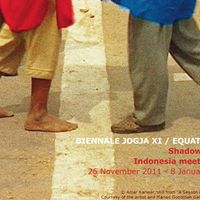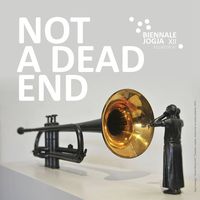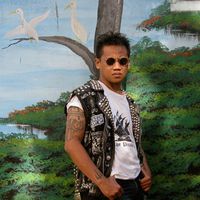Dialogue Across the Equator at the Jogja Biennale
 [caption id="attachment_18812" align="aligncenter" width="533" caption="Sakshi Gupta, Reality Bites, 2006"]
[caption id="attachment_18812" align="aligncenter" width="533" caption="Sakshi Gupta, Reality Bites, 2006"]culture360 contributor Bharti Lalwani speaks to the curators of the Jogja Biennale, Alia Swastika and Suman Gopinath to discuss the premise of the first international Jogjakarta Biennale titled Equator #1- Shadow Lines: Indonesia meets India. Here Spirituality, Religiosity and Belief are the themes explored by artists of the two countries which share centuries old trade and cultural ties.
(Key: AS: Alia Swastika, SG: Suman Gopinath)
B: Alia, although this is the eleventh Jogja Biennale, it is the first international biennale which chooses to examine its relations with one other country- India. Please tell us how this developed. (this is the theme for the next 10 years I understand?)
AS: The idea is to offer an alternative “International” Biennale which is not to be confused with the common understanding of the word which usually implies a large scale festival inclusive of artists from countries around the world.
The Biennale Jogja Foundation began developing the concept of an international biennale which, in essence, sought to be distinctive from current biennale trends. With limited infrastructure and resources, we chose instead to be focused on one particular region as a strategic approach to be a distinguished event on the map of the art world. Examining the equator as a geo-political concept steeped in history; it is interesting to retrace the equator as a focus of interest for this biennale. We did not want to only highlight similarities and differences (which also make for interesting comparisons) but we wanted to work specifically on regions round the equator showing an alternative rewriting of (art) history, where the “Western” model is not the only exemplar of a biennale.
B: Suman, you mentioned this is your first curatorial undertaking in Southeast Asia; how did this partnership with Alia and indeed Indonesia evolve?
SG: Yes, I have worked on several exhibitions in Europe, but this is indeed my first curatorial project in South East Asia.
I first met Alia and the artist Mella Jaarsma (who is on the board of the Biennale Jogja Foundation) when they came to India on a research trip at the end of February last year: they were looking for a curator they could collaborate with on this biennale.
When the Jogja Foundation invited me to curate the Indian section of the biennale, I was apprehensive at first, both by the enormity of the undertaking and the lack of time. But it was an offer I couldn’t refuse, and there were several reasons for this: firstly, the visual art scene in Indonesia was completely unfamiliar territory for me, I had seen images and read of artists from there, but had never had the opportunity to work with any of them before; I thought the biennale would give me the chance to view the world through a new lens, no longer the ‘West and the rest’ but countries that shared a common geography and a somewhat common history as well. The idea behind the biennale attracted me, I thought ‘biennale equator’ was such a good starting point to explore visually, different aspects of two countries that shared a past several millennia ago; most importantly, I suppose, was the fact that the board of the Jogja Foundation comprised of artists I had heard about and was looking forward to working with.
When I accepted the invitation to curate the Indian section, I was still in the process of completing other projects I was involved with, so it took a couple of months before we could actually start working on the theme that had been thought of in Jogja- reliogiosity, spirituality and belief. This was to provide a framework for the biennale and link two countries as vast and diverse as Indonesia and India. We had about six months to put this biennale together!
B: Keeping in mind the theme of Spirituality, Religiosity and Belief; all terms which have inspired cultural bonds as well as conflict throughout Southeast Asian history, what were your deliberations while selecting artists from both countries?
AS: First I listed artists who mainly work on the scope of this theme, such as Arahmaiani, Setu Legi, Christine Ay Tjoe and Albert Yonathan, then chose from their artworks (mostly from 2005 to 2010). Then I choose artists whom I knew were interested in this theme and commissioned them to make works for this biennale. Lastly I approached a few artists who may have never dealt with this theme but seeing as I was drawn to their aesthetic vision I thought we could explore some possibilities. The younger generation of artists certainly have different strategies or methodologies of creating art.
SG: As the theme is so complex and the associations the words bring to mind so vast and varied, I had to first work out the connotations for myself before I began to choose the artists. To give you just one example, the Oxford English Dictionary describes ‘religiosity ‘ as excessive religion, but in fact this term can be used in relation to religious identity, political identity, spiritual identity. I decided very early on that as the concepts themselves were fairly ‘abstract’ I didn’t want to show very literal works; rather, tangential references would be more interesting.
So, for instance we have Amar Kanwar’s film trilogy A Season Outside, To Remember, Night of Prophecy, that explores the tenuous links between religiosity and nationalism, religiosity and violence, violence and resistance. We have an artist like Shilpa Gupta whose wall-drawing with adhesive tape- Untitled (There is No Border Here) -talks about ‘borders’, religiosity and national identity. Or Pushpamala N, who makes subversive use of religious iconography through her re-created photographs ( from the Motherland series).
Sheba Chhachhi’s work Ganga’s Daughters, gives us a layered view of the ‘spiritual’: the portraits are of women ascetics, but intrinsic is the exploration of power – personal and, in one case, political power. Themes of the quest of immortality through the spiritual run through Chhachhi’s work.
‘Belief’ of course covers a spectrum of meanings from belief in oneself to belief in ideologies, to belief in fetishistic objects, bordering on superstition. So I did try to get works that referred to these different aspects.
Most of the works I selected were those of artists that I was already familiar with. The two constraints I faced were those of limited time at my disposal and limited funding as well. But I was lucky to get almost all the works that I wanted included in the exhibition, thanks to the generosity of the artists.
There were however three artists who made new work for the biennale. Valsan Koorma Kolleri - made a large site specific installation called Coherent Earth at the Jogja Museum from natural material which he found in Jogja, this installation referred to the living traditions and artisanal practices that are so much a part of everyday life in Indonesia and India ; N S Harsha’s- floor-drawing Reminder related to the philosophical question of the creation of the universe and K P Reji’s large tryptich School narrated the insidious effects of myths and legends on everyday life in India.
So in the India-section, we had 15 artists of varying age groups , ranging from the older established artists to the more recently established artists.
B: Suman, you have brought onboard the works of well established Indian artists such as Atul Dodiya, N.S Harsha and Sheeba Chhachhi. What were their responses on being invited to participate in the Jogja Biennale?
SG: They were all very happy and excited at the prospect of participating in this biennale. All these artists have shown their work extensively in the West so they were very keen to show their work to an entirely ‘new’ audience and I don’t think they were disappointed! Atul Dodiya, Valsan Koorma Kolleri, NS Harsha and K P Reji who were present for the opening were quite amazed to see the huge audience on the evening of the vernissage (especially so because there was such a large ‘young crowd’ who were interested and curious about the works from India).
B: How has this Biennale been supported in terms of funding? Have the Indian and Indonesian governments forged a partnership for this event as well? To what extent have you collaborated with Galleries and collectors? I understand there were some unfortunate speedbumps along the way such as some of the Indian works getting stuck at Customs; Please tell us about your challenges.
AS: The fund comes from different sources. First we got around 25 percent from the government. Second, we developed the so called "Friends of Biennale" association to gather support from collectors and galleries participating in this Biennale. We hope that this strategy will be continued into the next few years as currently their contribution amounted to almost 40 percent of the fund. The rest, around 35 percent of the fund was gathered by independent companies and businesses. Collectors also provided possibilities to lend their art works and support some collateral events.
SG: A number of galleries in Delhi, Bombay and Bangalore were really helpful when I was doing my research for the biennale. As time was limited, the gallerists showed me the works of all the artists they represented, so that I could then short-list the artists I actually wanted to meet.
In terms of funding, the Indian Government didn’t really play any part. The Indian Embassy in Indonesia however found sponsors who covered the costs of the airfare of the visiting artists from India .
And yes, it was not ‘some’ of the works that were stuck at the Customs, but all the works that had been freighted from India that got stuck. It was released less than a day before the opening, but I think it all came together in the end, the ‘jugaad’ factor (jugaad- a Hindi term that roughly means - a combination of optimism and creative improvisation that can overcome any constraints) worked in this instance!
B: This biennale was also a great opportunity to engage local artists, students and the local community at large. Tell us briefly about your public outreach programmes.
AS: In the Festival Equator and Parallel Events, more and more communities are being engaged in their activities so there are many aspects from the art world could be introduced to them in many different layers of understanding.
I commissioned some artists to work for community projects that involved students, the public, and local artists to be part of the creation process. Arya Pandjalu and Sara Nuytemans worked with students 9 to 12 years old in a village with the purpose of raising awareness of different religious groups and practices and the importance of tolerance in a multi-cultural society.
Gerobak Bioskop by Ruangrupa worked with youngsters to create a local movie program. Some artists also worked with students to create their own works of art and experience the creative process.
B: Alia, what's in store for the next few biennales? Which country will you be focusing on next?
AS: Next we would like to explore the Middle East, African countries, Macedonia and Pacific Islands and South America.
Bharti Lalwani has a BA in Fine Art and an MA in Contemporary Art; She writes for several publications across SE Asia and India, China and Australia.
Similar content
from - to
26 Nov 2011 - 08 Jan 2012
from - to
16 Nov 2013 - 06 Jan 2014






